To See from the Intelligence of the Heart
Published in: 30. On the WayAn interview with Richard Whittaker, editor, works & conversations (California)
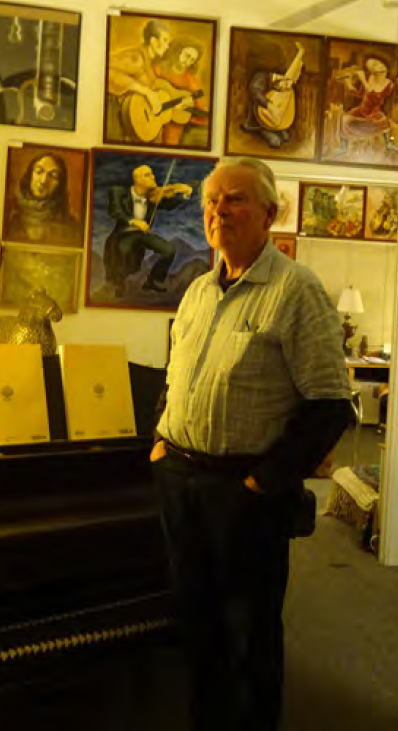
Richard Whittaker
When a cultural phenomenon transcends the usual categories, its specialness is often traceable to some individual shaping the character of the whole. The unconventional magazine works & conversations, which emerged in the San Francisco Bay Area in 1991 and whose reputation has long extended beyond the United States, stems directly from the sensibilities of founder and editor Richard Whittaker.
The magazine acquaints its readers with “works” — of art and other types of creative expression, often idiosyncratic and not widely known — and also explores its heroes through “conversations“: both internal monologues and unhurried, in-depth interviews with people whose exceptional qualities place them beyond the common measures and standards of the moment.
The leaven for these conversations is the integral part played by Richard Whittaker, who personally conducts most of the interviews and determines their range of subjects. The editor’s thoughtfulness and incisive instincts inform each aspect of the magazine’s discourses, whose subject always turns out to be life as such. But what happens in an interview with Richard himself? We get a special glimpse of a twofold calling to the craft of publishing and the art of communication – two converging paths to a space of mutual trust.
Trust in Richard arises easily, and conversations with him tend to touch on topics otherwise seldom broached. Even while chatting just before our interview kicks off, Richard reacts strongly to our mention of a Greek Orthodox priest — the only one serving in a certain city in California. Father John had upheld a custom of celebrating all church services with traditional chanting, often for many hours straight, and had done so whether or not he had even a single parishioner in the church — the company of an “angel at the altar” was enough.
works & conversations has an editorial board and a devoted circle of admirers. But namely the editor gathers them all at the “altar” where he himself continually presides. Subscriptions to the magazine are paid for — if paid at all — by voluntary donations. According to the publication, “The gift economy…is a whisper in the ear of the collective, a whisper insisting against the odds that there is another way of encountering this world and each other: through generosity.”
The spirit of generosity, as a guiding practical principle, is vitally present in this long interview with Richard Whittaker.
A complementary edit of this interview appears at works & conversations’ conversations.org.
AB — So, works & conversations. There’s something special about this magazine, in an American and really also a world context. Our Apraksin Blues was born in Russia, we’re creating it together with Russian authors and collaborators, and yet we can’t help but sense a consonance between what you’re doing and what we’re doing. It feels like a very personal endeavor on your part — the existence of this magazine and all the people and stories it draws together.
How would you define works & conversation for people who might be encountering it for the first time? What makes the magazine different, special — for you and your readers?
RW — Well, thank you — the way you describe the magazine resonates with me. It is really is personal. The magazine appeared quite without any plan. Spontaneously. When I look back, I see in that moment many strands below the surface converged.
It all began in the context of a little group of artists, of which I was a part. I was 47 and had just completed a Master’s degree in clinical psychology and suddenly found myself asking what I was going to do with the rest of my life. I’d had a relationship with art in different ways since I was a teenager, but I’d never said to myself, “I’m an artist.” My relationship with art was always outside of school. I eventually got a degree in philosophy. Then in 1989 I earned a Master’s degree in clinical psychology. But that education wasn’t in order to become a psychotherapist.
At that point, I looked at my life and saw that I’d never put my creative interests in the center, and I decided to do just that. So my wife, Rue Harrison, and I — she’s an artist and later also became a psychotherapist — pulled together a little group of artist friends. We’d meet once every couple of weeks to look at each other’s work and talk about it. It was very nice. You know, it can help artists keep their spirits up to get together. One day, as I looked around at our group, I realized that none of us had a real chance of being successful in the art world. It’s so difficult to become a successful artist, maybe everywhere, but certainly in this culture. I looked around the little group and said, “Okay. None of us are rich. None of us has powerful mentors. So we have to do something more than just make our artwork. If any one of us is going to get anywhere, we have to do something more — we should start a magazine or something like that.” I hadn’t thought about this; the words just came out of my mouth. And one of the artists, Dickson Schneider, said, “Okay, Richard. Why don’t you start one?” And then the next day, I did. So that’s how much planning there was for it.
I know it must sound sort of ridiculous, but the truth is that all of these strands really were there below the surface. For instance, my wife had been working at the Maritime Museum in San Francisco as the exhibit designer. They had a Hewlett-Packard scanner, and one day she’d showed me how to use it. I had a Mac Plus to get through my master’s program. And then Pagemaker, this early program for desktop publishing, was around, and I suddenly saw that I could scan images and combine text with them. It was amazing. There’s much more to it and I won’t go through it all, but I had a lot of tools already in my hands, so to speak. So that’s how it began. But there wasn’t a real sense of vision per se. That vision developed.
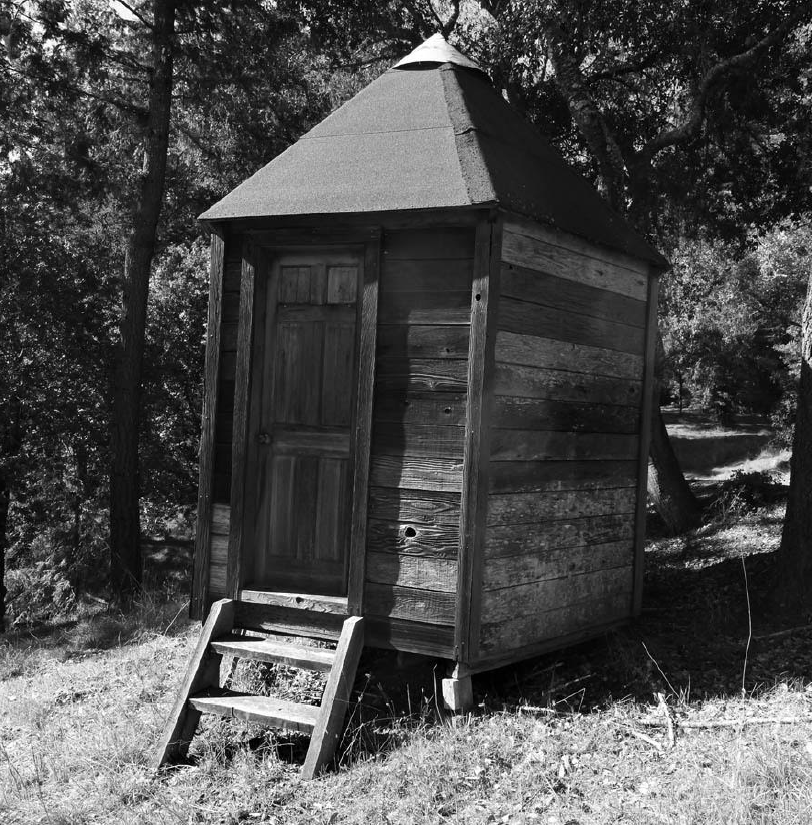
R. Whittaker. Ratna Ling, 2020.
Let’s talk more about the connection between the vision and the materials for realizing it.
In my art past, I’d gotten into ceramics, thrown pots, done some painting, some sculpture, and I’d made some furniture. All that stuff was great, but I hadn’t quite found my medium. I discovered photography by accident, and that was what really cut deep into my experience — and totally unexpectedly. In 1975, I’d picked up a camera, and by 1989, I had 14 years of experience with photography. In that time, I’d encountered incredible experiences of beauty. They were like religious experiences, and I thought that must be what art is really about.
What led me to photography was a feeling, almost of ecstasy, I’d had in the presence of beauty. All of a sudden I’d wondered if I could take a photo of what I was seeing, and then, later on, would I feel the same thing looking at the print as I was feeling right then in front of this beauty. So I got a camera in order to answer that question. And in fact, I sometimes did get an image that still held something of the original magic.
So I began to make prints and take them to galleries. Then I began to discover the realities of the contemporary art world in San Francisco: the conversation that was going on in the art world had nothing to do with beauty. That was a shock. Ultimately, I was so disappointed with this, it’s the key reason I started the magazine. Although I did make some efforts to skew some of my photography toward being fashionable, I soon gave that up. I couldn’t turn my back on my own experience.
My background in philosophy helped me. I wasn’t intimidated by the intellectual climate with its postmodern dismissal of ideas of deeper Truths that crossed all the cultural boundaries. And something in me gave me the temerity to think that I could make an effort to bring something out into the world that reflected what I found to be meaningful, and that maybe it would be useful for others who might feel the same. I must say I felt great apprehension about this: who am I to try to bring something into circulation? There was a lot of anxiety, but there was just enough of something else that tipped the scales in favor of trying. So, in brief, that’s the underpinning of the magazine.
Do you see the arts as a particularly special channel for identifying the sorts of experience that moved you?
Back in the early ‘60s there was a phrase: “art, philosophy and religion.” It was simply thought that these three categories were avenues to the deep reaches of human experience. In those days, the “grand narratives” hadn’t been overthrown by Derrida, Foucault and others. These were the avenues to mankind’s deepest truths: art, philosophy and religion.
My own deep experiences, I felt — simply intuitively — were real and true. I had no thought that they were somehow exclusive. There was no need for trying to analyze them. They belong in the realm of the mystical, I suppose. Certainly, they could find a home in religion — not in the dogma, but in experience. One can find a place for them in philosophy, too. I haven’t read enough of Bergson, but he might be an example. There are certainly others. I would say that some of the same problems I encountered in art discourse can also be found in the world of religion and philosophy — in areas where the intelligence of the heart has no place. Let’s put it that way.
As human beings, it’s hard to imagine finding meaning without having the participation of our deep feeling in some fundamental way. And that seemed to be missing in a lot of philosophy that I ran into. With religion there can be related issues, very broadly speaking. So I don’t feel what I’ve tried to show in the magazine is exclusively under the word “art.” Certainly I think of art as including all the creative categories — music, dance and so on. That brings us into the question of creativity, which overflows all of these categories into almost any area of life.
Would it be fair to say that the magazine is about the experience of creativity, in that general definition you’ve suggested?
Well, I don’t have the intention of exploring creativity as an idea in itself. I’m interested in instances marked by deep creativity. However, I can’t define any parameters here. So I don’t have an intellectual concept, particularly. I wait for something to start vibrating in me. It’s like hearing the sound of a bell in the distance. Some other part of me is a guide for the magazine. I listen to it. This is an interesting area to ponder, really: how do ideas and experience mesh?
That is, you’re not necessarily offering your own model or theory, but trying to hear, based on intuitive responses, the authenticity that others’ creations might bring to you?
Yes, I’m responding to my intuition. My hope is that what’s coming through me is shared by others. I don’t think that’s my ego; I think it’s something else, something sensitive, and I value that. I’m inspired by feeling and seeing something authentic in someone else, and I’m moved to help share such things with others.
This resonates with the question of how much the magazine is a personal statement. Some might say it’s just conversations with various people. How can it be a personal statement, even given the editorial sensibility? What kind of selectivity is taking place? Yet sometimes it’s as if the people you speak with are articulating ideas that could come from you, as if they’re speaking on your own behalf.
That’s a very astute observation, and I would have to admit it’s true. I often do feel someone is saying things on my own behalf. That may be just the nature of being in an editorial relationship with what gets selected. I look for things in some way connected with what feels most true to my own experience. I feel uncomfortable making pronouncements about maybe serving something larger, but I hope there’s some way in which that’s true. I have to trust this sensibility in myself. I don’t trust my ordinary thinking. That sort of gets disconnected. Another thing I’ve discovered is that when I describe my own experiences to artists, they know what I’m talking about. Artists have a lot in common.
At the same time, when I don’t feel a connection with something, I’m very careful not to get involved. Why would I? Because I want to be fashionable or because I want to sell magazines? That’s not what I’m interested in.
In following this path of discourse with artists, might you help them to have revelations about themselves, in a certain way?
That does happen, I think. It’s not unusual for an artist to say to me, “Nobody talks with me about this stuff. These are the things that are really important for me, but we artists don’t talk among ourselves about these things.” Artists often are isolated, they’re struggling and they easily get confused because of conflicting challenges and wishes. People need recognition, they strive for that, and they may be tempted to turn themselves into pretzels in order to get recognized. That means they sometimes let go of their more authentic connections.
The kind of affirmation I can give by featuring an artist can be very supportive, especially for an artist who isn’t being noticed. I know it helps, because most of us are hungry to be seen. It’s also true that people have different levels of self-confidence. There’s such a spectrum. So yes, I do think that sometimes I help other artists. That’s not an explicit mission per se.
The qualities you recognize may be emblems of a broader human quest.
I certainly hope so. Agnes Martin said all art is about beauty and that beauty isn’t personal. It’s transpersonal — although she didn’t use that word — it’s from something deeper and much broader than anything personal. I believe that’s true of real beauty, real authenticity, real truth. Those things really connect us, because they’re from deeper layers of ourselves.
I’m not a deep student of the postmodern critique. I recognize that the critique offered by Derrida and Foucault and others has a lot of validity. However, I think a lot was overlooked. Some of the deeper things in philosophy that go back, way back, and speak to the human connections across cultures, can be very powerful. The postmodern critique overvalued cultural relativity and missed the point on epistemology, saying it was always corrupted by issues of power, et cetera. Maybe a lot of that is true. But if you can get deep enough — and this is where a spiritual practice comes in — if you can enter into a deep enough state of silence, what one can encounter there is shared by, perhaps, all humans.
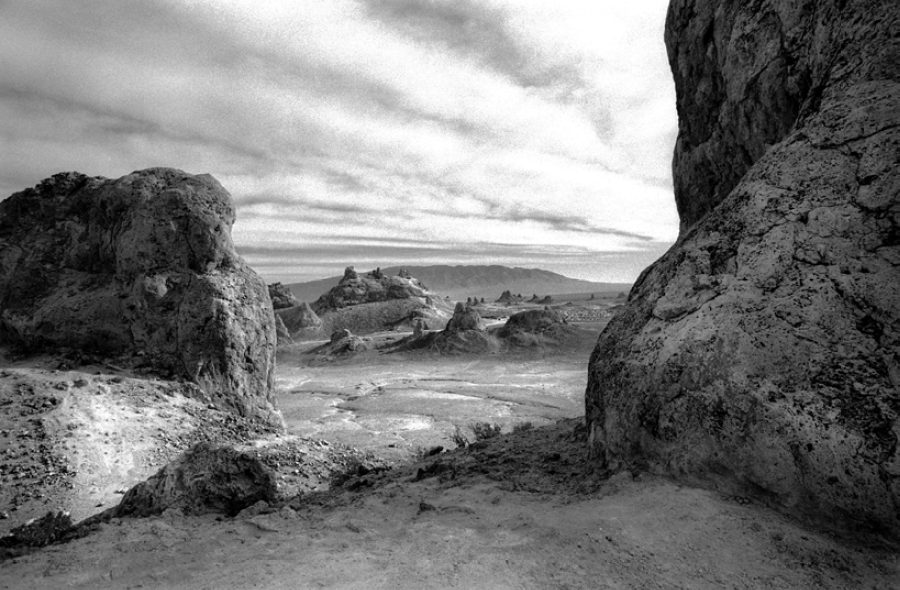
R. Whittaker. Trona, 2002.
Would you say that the practice of conversation, in your mind, is part of a spiritual discipline for nourishing authentic art?
That’s a beautiful question. As a matter of fact, I really appreciate your questions. I think that to really listen to another person and have a conversation is a deep thing, and something that’s mostly missing in ordinary discourse among people. Giving someone your focused, non-judgmental attention is special and powerful. Many people, maybe most of us, long for that kind of listener.
How might your work create something valuable from experience? What does human discourse mean for you?
The very exchange we’re having is a demonstration of what can come from a conversation. I couldn’t create this by myself and maybe you couldn’t create it by yourself, either. But between us, SOMETHING is appearing. I’m being given something by what you’re articulating and by the questions you’re asking.
My own experience shows that the unconscious is involved in the creation of every issue of the magazine.
A remarkable artist (Pat Becincasa), whom I recently interviewed, used the phrase “when you come down that cosmic baby chute into existence,” just in the middle of a sentence, and kept on talking. She had another phrase, too, “We all live in shadows and smoke.” That’s poetic and true. Our dialog helped each of us, I think.
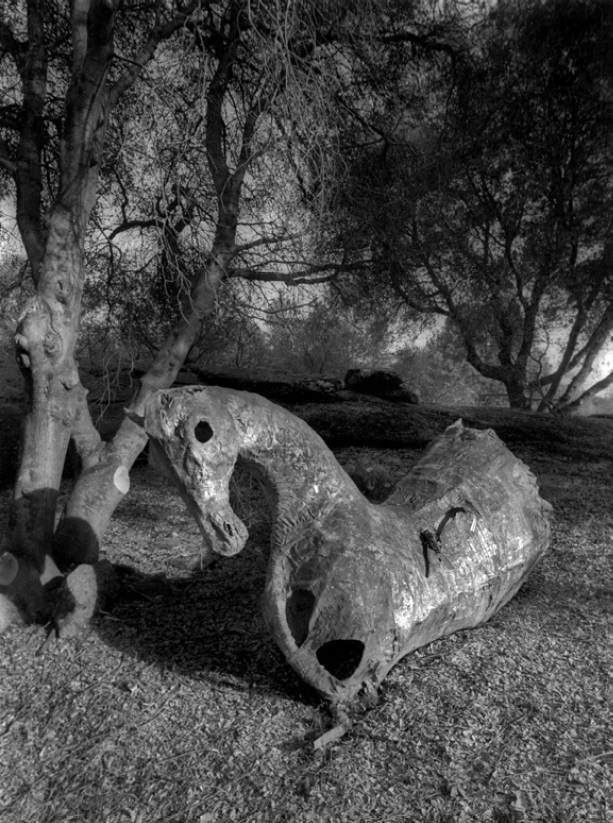
R. Whittaker. Lost Mariposa Garden, 2006.
Do you look for a person with certain qualities — as if for your magazine’s archetypal hero? In the most recent issue, for instance. It features Davis (Dimock) and Petra (Wolf) — how very different they are! Davis wants to be with his rocks and doesn’t want to go anywhere, whereas Petra never wants to stop. She wants to go everywhere. But they’re both your heroes.
Yes. They’re each following a deep truth in themselves. Perhaps everyone’s truth is its own particular journey. I love both of those stories. Both Davis and Petra are so true to themselves. It’s a search. It’s very mysterious that we’re in this world.
A remarkable woman I talked with not long ago, Doctor Rachel Naomi Remen, speaking about contemporary Western culture, said we’ve traded mystery for mastery. She said that’s not a good trade.
Doesn’t everybody hunger for a deep sense of meaning? And where does meaning come from? That’s a difficult question and hard to speak of adequately.
There’s also the question of discipline, having made a certain choice.
That’s very good, because this is like a spiritual path, where discipline is required. Many people don’t have a spiritual discipline, and they may long for something like that. Spiritual paths all have practices that require discipline. Like in a Zen monastery. And your story of the Greek Orthodox priest praying every service, even with an empty church — that’s a powerful example of an inner discipline. I must say, I’ve never heard such a story. It really touches me. But discrimination is needed. Some people have great discipline for very bad purposes.
Might you say, with the magazine, as much as you’re drawn to things you do understand and feel an affinity for, that you’re also drawn to things you feel challenged by and don’t understand — at least not immediately? Do you ever feel a desire to go beyond a certain opacity in your cognition of the moment?
Before answering, let me ask, is that question formed from something in your own life?
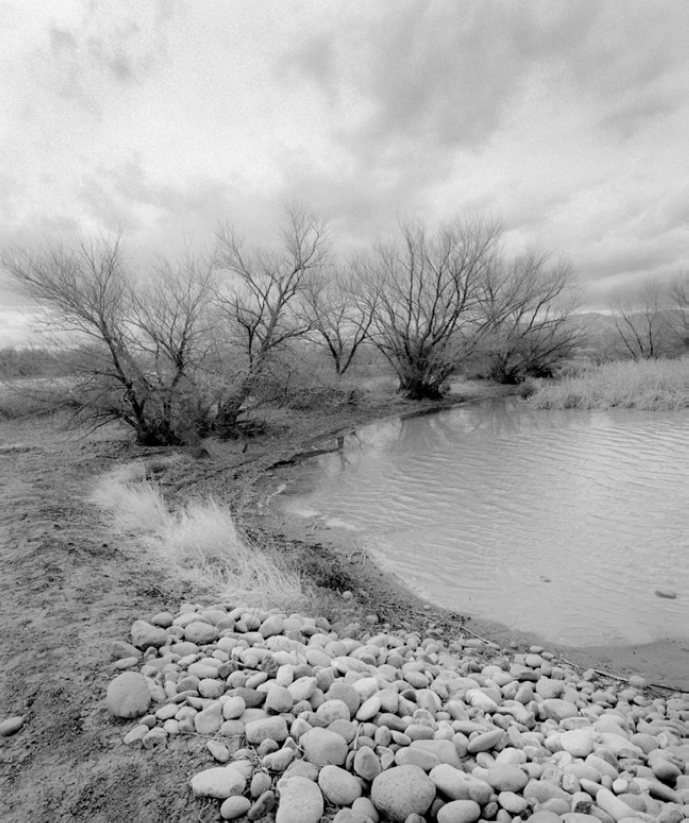
R. Whittaker. Untitled, 2005.
I think so. It also comes from reflecting on what it means to be a citizen of this country or a citizen of the world. Much of what has drawn me to linguistics, for example, and to various more complex cultural practices, is just a need for awareness of higher standards to feel reverence toward. Are you aiming for intellectual, cultural challenges, or to acknowledge their existence, within our American context? And does that indeed form a context for the magazine’s existence?
I don’t frame it in those terms explicitly. But I relate to your question on a personal level. Perhaps there’s something I want to do; I feel called, but I’m scared about it. I try to practice not letting my fears stop me. But that’s on a more personal level. I haven’t been attracted to political-cultural issues. That just hasn’t been my path. But the question of how one lives involves the question of to what extent does one obey one’s fears, and to what extent does one decide to proceed in spite of them. I think that’s an essential question, and it certainly is a living one for me. Sometimes when I interview someone, I have anxieties about it, especially if it’s a public event. It takes a kind of courage not to let my anxieties stop me. That’s sort of how I’m responding to your question.
So is there a societal source of fear that we need to perhaps overcome?
I don’t doubt that.
In our conversation, we’ve alluded to the pressure to achieve success in terms of commercial prestige. With your magazine, are you trying to create a non-commercial space for discourse and understanding?
No. I haven’t made any special effort to create a non-commercial space. It is a non-commercial space — very uncommercial. I’ve never made a dollar. I mean, if I looked at the money I put into it and what’s come my way, I’m still in the red. I didn’t intend to be non-commercial, but it turned out I didn’t have much interest in playing that game. I didn’t have much skill for it, either. So it’s an accident that the magazine is not commercial, but it’s an accident that’s slowly leading me toward a revelation of a certain kind of value that is not much recognized in this culture.
Our whole culture is about getting, about achieving. Of course, I’m enculturated with these values. So, in part, the magazine is a slow journey toward another value that’s not about getting, but about serving, about giving, about not being grasping. I have a long way to go, but the non-commercial fact of the magazine is actually giving me some unexpected gifts. I’m slowly discovering the joy of giving. Yes.
Those aspects of society are familiar enough to anyone. Another aspect of your work might be a willingness to go beyond the current moment. You referred to disenchantment with the postmodern, for example. Commercialism also demands being fashionable and very much of the moment. Do you seek out older or timeless reference points?
It’s not that I explicitly seek out something like that; I don’t worry about it. If I find something that touches a sort of feeling, I go with it and this takes care of itself.
You’re saying that you make no special effort to discover more fundamental, sturdy, ancient traditions, but in the magazine that comes out on its own. I’m often just pleasantly surprised when reading the magazine. Nearly everyone you feature turns out to be thinking very much about the past. They might appear to be in the present moment, living in the present, as we’re told to do for our greater happiness, but there’s a constant reference to things that have been, to ancient civilizations and scriptures. Does it also give you joy to have a sense of moving outside linear time?
Well, it’s just a reflection of my life. I’ve had an interest in wisdom traditions, let’s put it that way. I’ve done a lot of reading. I’ve been involved in my own spiritual work, you might say, and I do believe that a great deal of wisdom has been part of past cultures, largely now lost.
In Christianity, for instance, I’m struck by the desert fathers, the contemplatives out in the deserts of Egypt in the fourth century. The lives of those anchorite monks seem quite wonderful to me. And you see similar things in Buddhism. The Judaic tradition also has things where one can feel great wisdom.
Now we’re in such a mind-boggling time. One’s hard-pressed to know what to make of it. Where we are today and where to turn are such huge questions.
Many people are reflecting on that now, including our readers — they have their own conceptions of what is important in life and what to think of us: in the United States, in California, on the West Coast… You’re also the West Coast editor for the New York-based magazine Parabola. These names and places symbolize a progressive, perhaps more technologically oriented, society — despite a certain aspect of spirituality that the West Coast and California also symbolize. How do you perceive the tension between those forms of progressive drive?
Manuel Klarmann, he’s from Switzerland, was out here in Silicon Valley for a couple of years, forming his own company. He had an intense desire to be of service to the world in this difficult, dangerous time. He was collecting data on energy use, on carbon footprint in the food sector, the carbon cost for creating specific meals. He was making a careful, thorough energy audit, very time-consuming, and was putting together ways of producing meals with smaller carbon footprints. He figured he had the best database in the world on these things. His company was called Eaternity. I met him in this circle of people with ServiceSpace, a group I’ve been involved with for the last 13 or 14 years.
He said he’d decided to give his data away if someone asked for it, in spite of how that might hurt his own company. The greater good was more important to him. I asked if he’d be willing to be interviewed. During the interview, I said, “Manuel, you’ve been here in Silicon Valley in the heart of the digital revolution, deeply connecting with the tech companies here. (He had a presentation at Google and at Apple, for instance.) Do you feel there’s any hope for the world that’s going to come out of Silicon Valley? Do you feel there’s any hope for us that will be strictly from technology?”
His response was, “I don’t really know. I suspect what comes out of Silicon Valley will either save us or destroy us.”
It’s an open question, and what is my attitude? I don’t know. Some of it scares the hell out of me. Ideas like “the singularity,” about silicon life and all that stuff. It’s so, in my opinion, such a strange fantasy world.
Which very much excites some people.
Many people are very pumped up about it.
Does this make you wish to support a different anthropological truth than Silicon Valley represents?
I don’t think I have the wisdom or the knowledge to go that far. Silicon Valley is a manifestation of life. I’m heartened by some of the people I know and by many of their responses. They’re trying to use technology as a way for people to come closer to their own humanity and have greater relationships based on service and help. Do you have particular ideas about this yourself?
Recalling the story of Manuel and his collecting of data, then giving it away, the gift aspect seems somehow redemptive, turning the exercise in metrics into something more balanced. I’m concerned about our capacity for say, unmotivated action, or irrationally motivated action, in pursuit of excellence, of joy — for their own sake. So in the example of the Orthodox priest, it seems better not to know how many hours he spends alone versus how many with the congregation, and what is the exact productivity rate of that. It seems better not to think in anything remotely like those terms.
It’s better to think in purely musical terms — although it seems we’re forced into taking a scientific approach to how we feel, to how we learn, in a way that almost negates the experience of learning and feeling unless we take serious mitigating actions to the contrary.
What keeps getting left out in all this “progress” is the intelligence of the heart. I’m so deeply touched by the story of this Greek Orthodox priest! I’m happy to have heard this story. It shows something so needed and so valuable, beyond quantification, much deeper. I’m reminded of something Gandhi said, that “there’s enough for everybody’s need, but not enough for everybody’s greed.” All the religious traditions warn us against that sort of thing.
Maybe this brings us back to “trading mystery for mastery.”
One last question: what can we look forward to in your next issue?
Well, you’ll see an interview with the artist Pat Benincasa, for one thing, and an interview with Rosalyn White, who does all of the Nyingma Institute’s thanka paintings and illustrations for their publishing. And there will be a poem from Robert Lax. Lax was important in Thomas Merton’s life. He was a beautiful, beautiful example of a person not motivated by getting something. That what I know about the issue right now. It’s always a mystery to me what the next issue will be.

Speak Your Mind